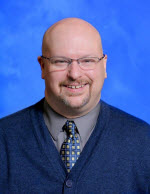
No Comments on LBA Profile: Bradley A. Long, MSLS, AHIP 265
Editor’s Note: Every other month, we publish the profile of a member of Doody’s Library Board of Advisors (LBA). The LBA has guided the development of our company’s library services since our inception. With gratitude, this month we present the profile of Bradley Long of the Harrell Health Sciences Library of the Penn State College of Medicine.
Where do you currently work and what is your position?
My current position is Embedded Health Sciences Librarian at the Harrell Health Sciences Library of the Penn State College of Medicine, at the University Park Regional Campus. I work 100 miles north of the main medical campus at Hershey, Pennsylvania, and just down the street from the Penn State main campus. Even though my regional campus does not have a true physical library, it is supported by the collections, resources, and services of both the Hershey medical campus and University Park main campus.
Provide a one sentence description of your library and its services.
I am embedded as a solo librarian within a nontraditional, active-learning medical school curriculum, which also does not have any required textbooks.
When do you start in medical librarianship? What was your position? With what institution?
My first job as a librarian was in the Health Sciences Library at the now-closed St. Francis Medical Center in Pittsburgh, where I worked from 1995 to 1999. I was the medical librarian on a staff of five, reporting to the Coordinator of Library Services. I was assigned to work directly with the hospital’s seven residency programs.
Name two of the most important issues facing medical librarianship today.
One of the biggest issues for our profession is how to effectively deal with the evolution of the publishing industry. As our print collections continue to diminish, we have to manage end-user discovery, nonuniform e-resource platforms, big package deals, open-access publishing, and open-education resources (OERs). As a direct result of this evolution, our patrons may never set foot in the physical library but could be using our collection more than ever before. Thus, we need to make sure that we are not invisible to the public or to our decision makers. We need to find ways to be better acknowledged as valuable contributors to everyone’s information needs.
In addition, we as a profession need to better understand the information-seeking behaviors of our end users. It is not enough anymore to just look at reference and e-resource usage statistics, along with door counts. We are starting to look at the usage behaviors of our end users beyond even surveys, focus groups, and website usability testing. We need to keep diving into the whys and why nots of their library resource utilization. This includes trying to replicate the ease of use of web search engines if we are to stay relevant in the future.
Why have you volunteered to serve on Doody’s Library Board of Advisors?
I have been working with Doody’s since 2001, first serving as the Library and Information Science Editorial Review Group Chair for Doody’s Review Service. I also have served on and off as a selector on Doody’s Core Titles since its inception in 2004. Over the years, I have written several book reviews for Doody’s Review Service.
When the opportunity to serve on the LBA presented itself, I immediately pursued it. I have the opportunity to advise a publisher that I not only know well, but also respect. Furthermore, the Penn State University Libraries encourages us to get involved with editorial boards, which is valued as part of our reappointment and promotion process. Thus, serving on the LBA also helps me professionally at my institution.
What is one thing you want to make sure all librarians know about Doody’s services?
In my last position, Doody’s Core Titles helped me to stay fiscally responsible, while still providing a quality collection to support a new medical school. I previously worked as the founding medical librarian for the start-up medical school at Central Michigan University (2012-2017). Doody’s Core Titles was an invaluable starting point for determining what the opening day collection would look like, with a smaller than expected collection development budget. Then, I kept referring to Doody’s Core Titles as my collection development budget stayed fairly flat, while the student numbers grew annually to the maximum enrollment.


Leave a comment